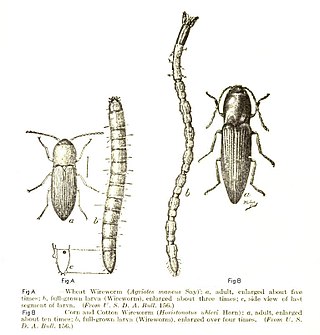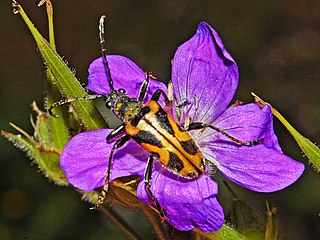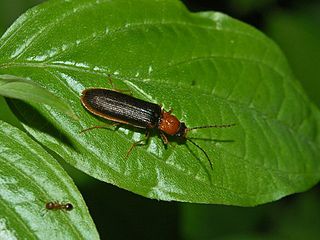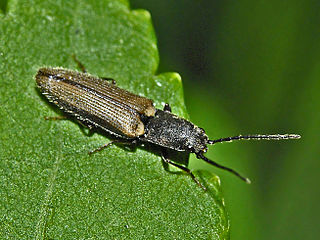
Elateridae or click beetles are a family of beetles. Other names include elaters, snapping beetles, spring beetles or skipjacks. This family was defined by William Elford Leach (1790–1836) in 1815. They are a cosmopolitan beetle family characterized by the unusual click mechanism they possess. There are a few other families of Elateroidea in which a few members have the same mechanism, but most elaterid subfamilies can click. A spine on the prosternum can be snapped into a corresponding notch on the mesosternum, producing a violent "click" that can bounce the beetle into the air. Clicking is mainly used to avoid predation, although it is also useful when the beetle is on its back and needs to right itself. There are about 9300 known species worldwide, and 965 valid species in North America.

Oedemera nobilis, also known as the false oil beetle, thick-legged flower beetle or swollen-thighed beetle, is a beetle in the family Oedemeridae, a common species in Western Europe, including the south of England.

Valgus hemipterus is a smallish species of scarab beetle found in the Northern Hemisphere.

Brachyta interrogationis is the species of the Lepturinae subfamily in long-horned beetle family. This species was described in 1758 by Carl Linnaeus in the 10th edition of Systema Naturae under the name Leptura interrogationis.

Pachyta quadrimaculata is a species of the Lepturinae subfamily in long-horned beetle family.

Clytus rhamni is a species of round-necked longhorns belonging to the family Cerambycidae, subfamily Cerambycinae.

Stenurella melanura is a flower longhorn beetle species of the family Cerambycidae, subfamily Lepturinae.

Denticollis linearis is a species of click beetle belonging to the family Elateridae subfamily Dendrometrinae.

Stenurella bifasciata is a species of beetle in the family Cerambycidae.

Cryptocephalus virens is a cylindrical leaf beetle belonging to the family Chrysomelidae, subfamily Cryptocephalinae. The species was first described by Christian Wilhelm Ludwig Eduard Suffrian in 1847.

Apoderus coryli, the hazel-leaf roller weevil, is a species of leaf-rolling beetles belonging to the family Attelabidae subfamily Attelabinae. Because of the trunk-like elongated head, it is often mistakenly attributed to the weevils.

Athous vittatus is a species of beetle in the family Elateridae and the genus Athous.

Chlorophorus varius, the grape wood borer, is a species of beetle in the family Cerambycidae.

Athous bicolor is a species of click beetles.

Anisodactylus binotatus is a species of ground beetle native to Europe. It was discovered as being introduced to Canterbury, New Zealand in 1938. Anisodactylus binotatus is a species of Carabidae, also known as the ground beetle family. Although this species of beetle has no official recorded common names, literature from England refers to it as the common shortspur beetle.

Elater ferrugineus, the rusty click beetle, is a species of click beetle belonging to the family Elateridae.

Larinus turbinatus is a species of true weevil in the family of beetles known as Curculionidae.

Aplocnemus alpestris is a species of soft-winged flower beetles belonging to the family Rhadalidae.

Luperus viridipennis is a species of skeletonizing leaf beetle belonging to the family Chrysomelidae, subfamily Galerucinae.

Athous emaciatus is a species of click beetle in the genus Athous.





















